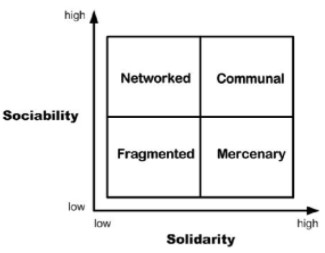ORGANIZATIONAL CULTURE
WHAT IS ORGANIZATIONAL CULTURE
Organizational culture includes an organization’s expectations, experiences, philosophy, as well as the values that guide member behaviour, and is expressed in member self-image, inner workings, interactions with the outside world, and future expectations. Culture is based on shared attitudes, beliefs, customs, and written and unwritten rules that have been developed over time and are considered valid (The Business Dictionary).
Culture also includes the organization’s vision, values, norms, systems, symbols, language, assumptions, beliefs, and habits (Needle, 2004).
Simply stated, organizational culture is “the way things are done around here”
FOUR TYPES OF ORGANIZATIONAL CULTURE
There are four types of organizational culture, which they created by using two dimensions: sociability and solidarity. Sociability is a measure for friendliness, and solidarity is a measure for the task orientation.
- High sociable culture indicates that people within the culture tend to be friendly to each other without expecting something in return.
- High solidarity means that people can work well together toward common goals, even when they have personal disputes or conflicts.
- A communal culture can give its members a sense of belonging and is also task-driven. Leaders of this culture are usually very inspirational and charismatic. The negative side is that they often have too much influence and members are rarely vocal.
- In a networked culture, member is as friends and family who have close contacts and care about each other. They are willing to help each other and share information. The negative side is that they are so close and kind to each other that they are reluctant to criticize the poor performance.
- A mercenary culture focuses on strict goals. The goals should be met and the job done quickly. Everyone focuses on goals and objectivity. The negative side is that those with poor performance may be treated inhumanely.
- In a fragmented culture, the sense of belonging to and identification with the organization is usually very weak. The individualists constitute the organizations, and their commitment is given first to individual members and task work. The negative side is that there is a lack of cooperation
HOW ORGANIZATIONAL CULTURE CREATED AND COMMUNICATED
Business leaders are vital to the creation and communication of their workplace culture. However, the relationship between leadership and culture is not one-sided. While leaders are the principal architects of culture, an established culture influences what kind of leadership is possible.
Leaders must appreciate their role in maintaining or evolving an organization’s culture. A deeply embedded and established culture illustrates how people should behave, which can help employees achieve their goals.
Leaders can create, and also be created or influenced by, many different workplace cultures.
ORGANIZATIONAL CULTURE AND KNOWLEDGE SHARING
The importance of a knowledge sharing culture as an enabler for the transfer and creation of knowledge is directly addressed by such authors as Bukowitz & Williams (1999), Davenport and Prusak (2000), and Gamble and Blackwell (2001). In order to make knowledge management initiatives work in practice, the employees within the firm must be willing to share their knowledge with others. Leaders must understand the culture both on an organisational and community level. While culture often exists on an organizational level, each community may have its own norms, perspectives, and collective understandings. Their willingness to share and to seek knowledge will be influenced by these collective views.
One major influence to a culture’s knowledge sharing willingness is the issue of reciprocity (Davenport & Prusak 2000). This refers to the individual’s need to perceive a current or future return on the knowledge he chooses to share. This could be in the form of direct compensation of some kind; it could be something intangible like enhancing the individual’s reputation; but it can also be the knowledge that the favor will be returned the next time he requires assistance.
Finally, internal competition is yet another aspect of organizational culture that may interfere with the knowledge sharing and knowledge creation process.
SOURCE
Kimiz Dalkir. (2017). Knowledge Management in Theory & Practice 3rd edition. 3rd Edition. MIT Press. Cambridge, Massachusetts. ISBN: 978-0262036870.
https://www.tlu.ee/~sirvir/IKM/Knowledge_Management_Infrastructure/organizational_culture_3.html
http://www.knowledge-management-tools.net/organizational-culture.html



